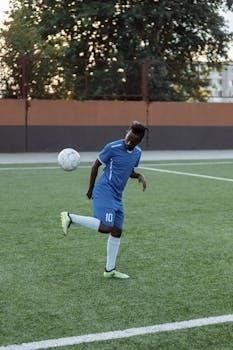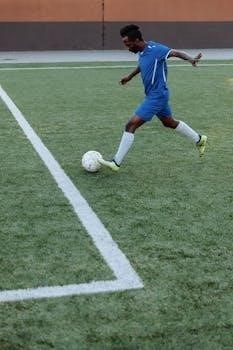
Effective youth flag football practice plans are crucial for developing young athletes. These plans should incorporate fun, engaging drills that build fundamental skills. Structured practices enhance player development. They also make the game more enjoyable and safe for everyone involved.
Importance of Structured Practice for Youth Flag Football
Structured practice is vital in youth flag football for skill development and safety. Organized sessions help players learn fundamental techniques effectively, maximizing their improvement. A well-planned practice ensures that all players receive equal attention and opportunities to develop. Structured practices also minimize wasted time, keeping players engaged and focused. This approach aids in building team cohesion, fostering sportsmanship, and improving decision-making skills. Furthermore, a proper structure reduces the risk of injuries by ensuring players are adequately warmed up and understand the drills before participating. It’s a foundational element for success in youth flag football.
Warm-Up and Conditioning Drills
Effective warm-ups and conditioning are key for youth flag football. They prepare muscles, build endurance, and enhance agility. These drills help prevent injuries and improve overall performance.
Dynamic Warm-up Exercises for Flag Football
Dynamic warm-up exercises are essential for flag football, preparing young athletes for the game. These warm-ups should include movements like high knees, butt kicks, and karaoke. These drills improve agility, footwork, and flexibility. Incorporating sprints and form running drills will further enhance readiness. Remember, a controlled, fast pace is better than an all-out sprint, helping players stay in control. These exercises help prevent injuries and get the muscles ready for the more strenuous activities ahead, ensuring a safe and effective practice session for all.
Conditioning Drills to Enhance Endurance and Agility
Conditioning drills are vital for building endurance and agility in youth flag football. These drills should focus on improving strength and flexibility. Cone drills, for instance, enhance footwork and maneuverability, while shuttle runs develop speed and change of direction. Incorporate exercises that target muscles not always used, boosting overall fitness. Running at a controlled, fast pace is more beneficial than sprinting, allowing for better control. These drills prepare players for the demands of the game, ensuring they can sustain their performance throughout practice and games, reducing fatigue, and maximizing their potential.

Offensive Skill Development
Offensive skill development is key in flag football. This includes enhancing passing accuracy and distance. Running drills are also important for speed and agility. These skills are vital for successful plays.
Passing Drills for Accuracy and Distance
Passing drills are essential for developing quarterbacks and receivers. Focus on proper throwing mechanics, starting with drills on knees to isolate arm motion. Progress to standing throws, emphasizing accuracy over distance initially. Incorporate target practice with cones or stationary targets. Introduce moving targets to simulate game scenarios. Gradually increase the distance of throws as accuracy improves. Remember to emphasize the importance of grip and release. Coaches should encourage players to throw thirty to forty times to improve their passing proficiency. These drills help players build confidence. They also help players develop the skills needed for successful offensive plays.
Running Drills for Speed and Agility
Running drills are vital for developing speed and agility in flag football. Utilize cone drills to improve footwork and cutting ability. Encourage controlled, fast-paced movements rather than full sprints. Plant and pivot off the outside foot when cutting to avoid tripping. Incorporate shuttle runs to improve change of direction. Practice quick route changes to mimic offensive plays. Focus on maintaining balance and control while maneuvering. Include ladder drills to enhance foot speed and coordination. Remember to emphasize proper running form, and keep knees high. These drills will improve a player’s ability to evade defenders and gain yards, leading to successful plays.
Defensive Skill Development
Defensive skills are key in flag football. This includes flag pulling techniques, defensive positioning, and strategy. Practice drills that improve reaction time and pursuit. These drills enhance overall team defense.
Flag Pulling Techniques and Drills
Mastering flag pulling is crucial for effective defense. Players should practice proper flag pulling techniques, focusing on speed and precision; Drills can include chasing and pulling flags from a running player. It’s important to emphasize not grabbing the player. Instead, focus on pulling the flag with a swift, downward motion. Repetitive drills help develop the muscle memory necessary for consistent flag pulls. Use a variety of scenarios, such as one-on-one flag pulling and team pursuit drills, to enhance skills. Proper footwork and body positioning are essential to successfully pull flags. Consistent practice will improve defensive efficiency.
Defensive Positioning and Strategy Drills
Effective defensive positioning is vital in flag football. Strategy drills should focus on teaching players how to cover receivers. Proper spacing is also important. Players need to learn how to anticipate offensive plays and react quickly. Drills can simulate various offensive formations. This helps players understand their roles and responsibilities. Practice should include zone and man-to-man coverage techniques. Communication is key, so players must learn to work together. Defensive drills will involve moving and adjusting to the offense. These strategies will make the defense more effective. Consistent training in positioning will improve the team’s performance.

Practice Drills and Games
Fun and engaging drills are essential to reinforce skills. Games that simulate real scenarios help improve decision-making. These activities keep practices dynamic and enjoyable for young players. They are crucial for skill development.
Fun and Engaging Drills for Skill Reinforcement
Incorporate drills like “Jingle-Jangle” to improve agility and footwork. The “Circle of Love” drill can enhance passing and teamwork skills. Flag pulling drills, like the one where players chase each other, add a competitive element. Use relay races to practice snapping techniques. These drills aim to keep players active and interested. This helps them develop their flag football skills, including throwing, catching, and flag pulling. Make sure to add a fun element to avoid monotony during the drills. These drills should be adjusted to suit the players’ age and skill level.
Game-like Scenarios to Improve Decision Making
Creating game-like scenarios is crucial for developing players’ decision-making abilities. Implement drills where players must react to defensive formations and make quick choices. Use drills that simulate real-game situations, such as a quarterback evading defenders before throwing. Set up 1-on-1 drills where offensive players try to gain yardage while defenders attempt to pull their flags. This type of practice helps players to learn how to read the field. It also allows them to make the right decisions under pressure. These scenarios will help build their game-sense and strategic thinking.

Practice Plan Organization
A well-organized practice plan is essential for optimal learning. Structure sessions with clear time allocations for each drill. Effective time management ensures smooth transitions. This maximizes player engagement and skill development.
Structuring a Practice Session for Optimal Learning
To maximize learning, a practice session should begin with a dynamic warm-up, progressing to skill-specific drills. Focus on both offensive and defensive techniques, ensuring balanced development. Incorporate game-like scenarios to enhance decision-making. Conclude with a cool-down to prevent injuries. Clear instructions and demonstrations are crucial for effective learning. Coaches should provide positive reinforcement and constructive feedback throughout the practice. A structured approach, moving logically from one activity to another, keeps young athletes engaged and promotes skill mastery. Remember, the goal is to make learning fun and effective, ensuring each player progresses in their abilities.
Time Management and Transitioning Between Drills
Efficient time management is key to a successful practice. Allocate specific time blocks for each drill, ensuring all aspects of the game are covered. Use a whistle or clear verbal cues to signal transitions between activities. Minimize downtime by having the next drill set up before the previous one ends. Keep transitions quick and smooth to maintain momentum. A well-planned schedule prevents boredom and keeps players engaged. Coaches should be mindful of the time to ensure there is enough time for every drill. This also ensures that all players are active. A well-organized practice maximizes learning and skill development.

Additional Resources and Tips
Explore free printable flag football playbooks to enhance your team’s strategy. Coaching strategies focusing on encouragement and skill development are also beneficial. Utilize online resources for new drills.
Free Printable Flag Football Playbooks
Accessing free, printable flag football playbooks can significantly aid coaches in organizing effective practices and games. These playbooks often include a variety of offensive and defensive strategies tailored for youth players. They provide visual aids that can be easily understood by young athletes. Furthermore, these resources can be cut and placed into wristbands for easy reference during games. The availability of these playbooks online makes them an invaluable tool for coaches looking to enhance their team’s performance and understanding of the game, simplifying play calls and strategy implementation.
Coaching Strategies and Tips for Success
Effective coaching in youth flag football involves more than just running drills. Coaches should focus on developing a clear strategy, deciding on a preferred style of play, and planning accordingly. Encouraging players and providing constructive feedback are crucial for their development. It’s also important to emphasize fun and engagement to keep young athletes motivated. Coaches should also adapt their strategies based on the skill levels and needs of their players, ensuring that every player has an opportunity to improve and contribute to the team’s success, fostering teamwork and sportsmanship.